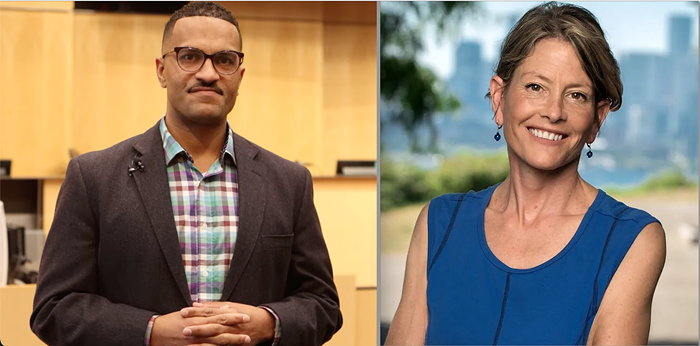On the west side of Aurora Avenue, on the Queen Anne side of the bridge, there's a slope of city park covered densely in ivy and blackberry bushes, crisscrossed by a series of crude trails forged by homeless campers, who marked their territory in their usual way: with debris—just enough to ward off intrusion from the homeowners atop the hill.
Then Rama Fire came along. Fire (as his name attests) was born to hippie parents and grew up on Vashon Island. He is 29 and has jumped BMX bikes ever since winning his first in a grocery-store raffle at the age of 7. Last summer he decided that there ought to be a BMX course near downtown Seattle—and that he would build it.
It's an illegal enterprise, technically. But to Fire and his friends, the end justified the means.
MacLean Park, near the intersection of Taylor Avenue North and Newton Street, had soil that, in Fire's judgment, would be both easy to dig and solid to pack. But Fire also needed a spot that had few trees, which is what led him to a section of the park where there was no trail—just six-foot-high ivy so thick the ground couldn't be found. It took Fire and a friend two hours with a machete to hack through 30 feet of weeds to reach the hilltop, where the ivy grows vertically into a wall. Seclusion was another prerequisite, and to Fire's eyes, the spot had potential. "Once we came back here, I could visualize it," he says. On his next visit, he brought a shovel and a pick, "and then we just started digging toward it, one jump at a time."
That was August 2005, and as word of the project spread, more volunteers came. Fire is a leader of Northwest Crew, a BMX organization that spans Washington and Oregon, and fellow riders went to the park after their jobs as grocery cashiers or bike salesclerks or substitute teachers to tackle the messy business of landscaping, all of it performed by hand. Their work was regular enough that it's easy for Fire to calculate the number of volunteer hours they devoted to the course's creation: 5,000.
That persistence was enough finally to conquer the patience of the vagrants, who shuffled off to more private environs. Fire and friends cleaned up the rubbish left behind. Before long, neighborhood residents began venturing through the woods.
Rebecca Krida, who lives near MacLean Park, had only just started exploring the vagrant-free terrain with her two dogs when through the tree branches she saw the sun shining off what looked like boulders, then as she got closer, like ancient burial mounds, except the digging here was recent. "It was a magical place," she says. Krida spotted freshly planted tomato plants, and on her next visit she brought a pitcher of water.
Another dog walker, Brian Fritz, who owns a condo close to the park, could see with what care the ferns natural to the hill were preserved; how only the invasive plants were removed. Rock sculptures took shape along the side of the course, and Fritz noticed that the dips of the bike jumps had been designed to drain rainwater.
It was all the meticulous handiwork of Rama Fire, who claims 15 years experience designing BMX courses—starting in his own backyard. Fritz, Krida, and others in the neighborhood eventually crossed paths with the BMXers.
Fire gives all newcomers a tour of the course. It is a triumph of engineering: Beginning at the hill's highest point, the biker can, with a single flip of his pedal, fly down a slope and propel himself over 10 jumps—reaching heights of 10 feet above the ground—until he arrives—improbably, entirely by the force of his own momentum—back at the course's start.
The tour comes with a demonstration, by Fire or by Chris Eimen or Adam Provo, his professional BMX rider friends. It's a marvelous spectacle, the biker swooping just beneath overhanging tree limbs, flying level with the leaves, like Tarzan on two wheels.
Botany appears to be another hobby for Fire: With pride he points out the rhododendron, a birthday present from his father, a landscape architect. There are cucumbers, an herb garden with thyme, sage, parsley, chamomile, and rosemary. A smiling face with a protruding tongue is carved pumpkin-like into the wall of one jump. When the course was completed last June, the group needed spectator benches, and fashioned some from packed dirt and low-curving tree trunks.
Inevitably, a city official eventually joined the audience. In October, Seattle Department of Neighborhoods officials hosted a gathering of neighbors to discuss the Ivy-Out program, in which volunteers weed invasive plant species from city parks. Someone saw activity deep in the forest, and the excavation was discovered. This is city property, and the city is concerned that the course's landscaping could make the hillside unstable and potentially lead to a mudslide onto Aurora Avenue.
Fire had a contingency plan ready in the form of Jack Tomkinson, executive director of Urban Sparks, a nonprofit that helps citizens who want to make enhancements to city parks.
"We try to get the essence of what the project is and then communicate that to others—in particular, the powers that be," says Tomkinson. He is less confrontational than many of the advocates who approach Seattle Parks and Recreation Superintendent Ken Bounds, and Tomkinson believes that was the reason he was able to convince Bounds to visit the course on July 6 for an exhibition of the course's social merits. Neighbors like Krida and Fritz came to voice their support. The riders gave a high-flying performance. And they showed Bounds how their drainage system disperses water evenly down the hill.
In the next few weeks, geologists will visit the park and report their findings to the Parks Department. If the hillside is deemed unstable, the course will be bulldozed.
Fire has no regrets about his method. He could have tried to sell city officials on the idea before he started digging, but the merits of BMX courses are better demonstrated than described. "I went about it the way I did because there wasn't another way," says Fire. "This sport had not been addressed (by the city park system), so we did all we could do to present it to them in a positive way, and then ask for their approval."


















